Excerpt from “Tantra, Mantra and Yantra of Sri Vidya” by Vinita Rashinkar
Sri Vidya is the knowledge of the Cosmic Mother who is the absolute reality, an embodiment of unsurpassed beauty and joy, the queen of the three worlds (sleeping, dreaming and waking). The entire Universe is her manifestation and the relationship she shares with the world is akin to that of the ocean and the waves that arise from it and subside in it.
Once we embark on the path of spiritual evolution, we all have to carve out our own unique little roadways to reach our ultimate destination. In many ways, this exploration can be likened to crossing a dense, often dark, uninhabited, virgin jungle. We have to cut through vegetation (much like how we have to hack our way through the obstacles that life places before us), remove prickly and thorny bushes from our way (as we have to deal with difficult situations which cause irritation in everyday living), be cautious to not get entangled in the low hanging vines (similar to keeping ourselves protected from toxic relationships and attachments) and most importantly, be entirely mindful of random pieces of driftwood which can cause us to trip and fall (just as we have to beware of tripping on our own egos and suffering a great fall). We also have to go through dark patches knowing fully well that we will soon reach the light. This journey is exhausting, often soul-wrenching but at the same time, it holds the promise of permanent joy and contentment.
In the Kubjika Tantram, Lord Shiva defines Sri Vidya as:
“Sridatri cha sada vidya Srividya parikirtita”
The vidya that renders prosperity and abundance is called Sri Vidya.
Our ancient texts and modern gurus are all in agreement on one aspect of Sri Vidya: in order for a person to practice this elegant and powerful discipline, one must have done thousands of years of sadhana in previous lives. It is said:
“Athava paschimam janma athava sankarah swayam”
This knowledge only becomes available to one who is in his/her final birth or is verily Shiva Himself. Our seers point out that if a person who is not deserving of initiation into the practice but still is lucky enough to be exposed to this valuable knowledge based on some good karmas from the past, such a person may not reach Self Realisation in this lifetime but will surely enjoy a head start in his next life.
The Sri Vidya is an ancient Shakta Tantra school of wisdom that is focused on the worship of Shakti, the feminine principle. Its ultimate goal is Self-Realization which is achieved through devotion to the primal force of Shakti which empowers Shiva who is otherwise in Samadhi ( in fact this is very forcefully expressed as Shiva is merely “shava” or corpse until he unites with Shakti) and this union of Shakti and Shiva gives rise to all aspects of the Universe including creation, preservation and dissolution.
Scholars point out that Sri Vidya is not a philosophy like Advaita Vedanta or Sankhya. It can be termed as an “upasana paddhati” or a practice-related science. Most of the Sri Vidya texts are focused on the practical aspects of how to acquire this knowledge rather than about its philosophy. Swami Amritananda Natha Saraswati says Sri Vidya is advaita in action precisely because it stands at a point where soaring philosophical theory transforms into experience and outcomes .
Sri Vidya practice comprises of tantra (a technique or framework for worship) whose two main elements are mantra (sacred sound) and yantra (sacred geometry). Tantra can be described in simple terms as the utilisation of the mental faculty to pursue the objectives of worship using mantra and yantra. Mantra is the use of sound energy to bring about oneness with the Divine while yantra is a geometric drawing which serves as a tool to reach the Divine.
Srividya is a systematic, esoteric discipline combining elements of knowledge, devotion and ritual. In the Shakta tradition Srividyopasana (the pursuit of enlightenment via Srividya) is considered to be the pinnacle of human achievement as it promises the practitioner an experience of union with the Ultimate Reality or Consciousness.
In the tradition of the Sri Vidya, the Self is worshipped as a deity and mantras are offered to the divinity (seen as the Yantra inside our body) that lies within us. Many Vedic scholars describe Sri Vidya as the embodiment of the tantric experience and see all forms of tantric practices as subsumed in its practice.
Sri
Vidya delves into the hidden essence (tattva) behind nature (prakriti) and
throw up concepts that deal with the secrets of creation, absorption and
dissolution. Ganapathi Sachidananda Swami says: “It teaches us about the divine
light (Chaitanya) and its essence (tattva). It is not any tantric worship but
is very pure knowledge (shuddha vidya). The word ‘Sri’ is neither male nor
female. It is not stri (feminine) vidya, but Srividya.
Chaitanya is the supreme light or knowledge that
glows secretly and naturally within the being. This divine light (chaitanya) is
visible to different people in different forms based on their tastes.”
There are two approaches to understanding Sri Vidya:
- Srishti krama (the basis of creation)
- Samhara krama (the basis of dissolution)
Srishti karma is the process of delving into the secrets behind the process of creation. Lalita Tripurasundari is worshipped first, and from her all the other goddesses are extracted, until all are in their rightful places. This is translated into a meditation of the Sri Chakra Yantra starting from the Bindu, which is the seat of the Goddess to its outer boundaries traversing through the nine avaranas.
The word ‘Samhara’ means absorption and merger. Each of the goddesses is worshiped and is absorbed into the next until we reach Lalita Tripurasundari, in whom, by which time, all the Devis are absorbed. In Sri Chakra Yantra meditation, we begin at the outer boundaries of the yantra and move inward through the nine avaranas to eventually reach the Bindu and be one with the Goddess.
These two approaches are balanced when one studies Sri Vidya and the practitioner uses Srishti krama to manifest his life’s desires and create his own future as per his wishes while utilizing Samhara krama to dissolve and eventually destroy all karmic bonds. This balance of the two kramas helps the practitioner to gain temporal and material benefits while also ensuring spiritual gains.
Swami Veda Bharati explains creation and dissolution thus: “Expansion and contraction in space are an identical process, just as creativity and entropy are interwoven. The boundaries between evolution and devolution cannot be determined. They are two sides of the same coin. This expansion and contraction are not opposite principles. They are not to be studied or even thought of in sequence. Evolution is devolution. Creation is dissolution. Creativity is entropy. The beginning is the end in any loop. And the universe is nothing if not a loop. There is nothing in the universe that is not a loop, a chakra, where one does not return to its origins.”
So, what is Sri Vidya?
Sri Vidya is the sacred knowledge of Lalita Tripurasundari (often referred to as Rajarajeshwari) who is Adi Mahavidya or the primordial Wisdom Goddess. She is conceptualized as the supreme deity, a beautiful and auspicious manifestation of Mahadevi, the Great Goddess. The knowledge of the ritual worship of Lalita Tripurasundari using mantras such as the Panchadashi and Shodashi along with meditation on her yantra (the Sri Chakra Yantra) all come together to form Sri Vidya.
Vidya means knowledge (“vid” means “to know”), learning, discipline and a system of thought, andwhen the word Sri is prefixed to it, it becomes knowledge which is auspicious, beneficial and conducive to prosperity. Sri is also the name given to the Mother Goddess who rules over the universe (tvam sris tvam isvari). She is called the mother because all living beings depend on her for the fulfilment of their destiny.
Swami Veda Bharati writes in an article titled “What is Sri Vidya”:
“Sri was a title originally reserved in ancient times for those who were initiated into Sri Vidya – they in whom God’s glory of the universe has made a home, those who are endowed with knowledge, empowered with the energy and the intuition of mother Sri. The basic text of Sri Vidya says: one who knows mother Sri can never be orphaned. In the rituals and ceremonies in the Indian tradition, when one sips the holy water they say, Mayi Shrih Shrayatam: may Sri dwell in me. The word for refuge is Ashraya: to be one as Sri. “May many come taking refuge in me, may I seek refuge in none”–is the prayer of those who wish to have this capacity to give refuge. This capacity is Sri. One might translate Sri Vidya as the science of capacities, the science of potentialities.”
Shakti is the source of all the principles and energies of the universe. The immense diversity of the manifestations of Shakti are seen in nature – in all cosmic bodies, forces, nature, all of life’s creations and human beings. These are all expressions of Shakti’s vidya. Therefore, the symbols of these energies and their expressions are regarded with immense awe, wonder and reverence and known as “Maha” (great) Vidya.
Devi Puranas and Bhagavata expound the glory of Shakti as the upholder of the cosmic order. The Mahavidya tradition restricts itself to only dealing with the diverse forms of Shakti that pervade all aspects of reality. Even though Her vidya is infinite and all-pervasive, it is classified into ten Mahavidya for the purpose of simplifying the sadhana for the seeker.
The tantric texts speak of ten wisdom goddesses (Dasa Mahavidya) whose worship brings about health, happiness and wealth in this life and liberation from the cycle of death and rebirth thereafter.
The origin of Mahavidya as a group is quite unclear. Historians are of the view that Mahavidya as a cluster of ten is of comparatively recent origin, possibly between the 12th and 14th centuries. It is entirely plausible that it began as a revolt against Brahmin notions of purity and differentiation (much like Shaktism had at an earlier point in time). A cursory study of Mahavidya shows a definite urge to return to more primitive and indigenous faith as it is based more on human experience and draws from aspects of humdrum existence.
Devadutta Kali writes in the Power of Consciousness that “the highest spiritual truth is that reality is One. That reality, when personified as the Divine Mother, expresses itself in countless ways. The ten Mahavidya, or Wisdom Goddesses, represent distinct aspects of divinity intent on guiding the spiritual seeker toward liberation. For the devotionally-minded seeker, these forms can be approached in a spirit of reverence, love and increasing intimacy. For a knowledge-oriented seeker, these same forms can represent various states of inner awakening along the path to enlightenment.”
The Mahavidya represent ten different aspects of the One Truth – the Divine Mother is adored and approached as 10 distinct cosmic personalities.
A story from the Shakta-Maha-Bhagavatha-Purana narrates the origin of the Dasa Mahavidya. Sati, daughter of Daksha Prajapathi, is madly in love with Shiva and marries him against her father’s wishes. Daksha, an arrogant and angry ruler, decides to conduct a yagna to which he invites all the gods except his son-in-law Shiva. This angers Sati greatly as she sees it as an insult to her husband and makes up her mind to attend the yagna. She goes to Shiva to seek his permission but he refuses to let her go stating that even if she went, the fruit of the yagna would remain inauspicious.
Sati gets very angry with Shiva at what she perceives to be an affront to her intelligence and wishes to show him her own power. She assumes the shape of the Divine Mother in all her might. Shiva gets afraid and tries to escape her wrath. She appears in ten different forms, guarding each of the ten directions. These Goddesses jointly subdue Shiva’s resistance and Sati goes on to attend the sacrificial ritual.
Each of these forms of
the Divine Mother has been given a name, story, quality and their own mantras.
KALI – The first in the series of the Wisdom Goddesses represents the power of consciousness in its highest form. She is Adi Mahavidya or the primary vidya. She is beyond time and space and seen as a “Devourer of Time” and worshipped as the very essence of the Brahman.
Kali is, at once, the supreme power and ultimate reality, bringing home the fundamental tantra tenet that consciousness and the power of consciousness are both the exact same thing.
The first transcendent cosmic power takes away all darkness and fills us with the light of wisdom; hence, she is the very embodiment of Jnana Shakti. She symbolizes the power of transformation. The rest of the Mahavidyas emanate from Kali and reflect her virtues, powers and nature in varying shades.

TARA – The Goddess is variously understood as “a star” who is beautiful but perpetually self-combusting. She is seen as a guide and a protector who helps her devotees “to cross” the ocean of worldly existence. Tara symbolizes everything in the cosmos that is absolute, unquenchable hunger that propels all of life. She, therefore, symbolizes the gracious liberator.
Tara’s symbolism is often related to death but, in its broadest sense as the death of the ego, she removes the mistaken notions we have of our own identities.

LALITA TRIPURA SUNDARI – She is one who is “the most beautiful in the three worlds.” The three worlds could variously be described as:
- The three states of consciousness – sleeping, waking and dreaming
- The three aspects of humanity – the physical body, the causal body and the astral body
- The three aspects of the universe – matter, energy and thought
- The three aspects of energy – Iccha Shakti (the energy of will), jnanashakti (the energy of knowledge) and kriyashakti (the energy of action)
Tripurasundari is also known as Lalita or the one who plays. The Hindu spiritual tradition asserts that the whole of creation is nothing more than a beautiful, charming game or play of the Divine Mother.
Tripurasundari is shown with four arms holding five arrows of flowers, a goad, a noose and a sugarcane bow.
The five arrows symbolize our five senses; the goad represents repulsion; the noose stands for attachment; the sugarcane bow is an analogy for the mind.
She symbolizes our need to purify our awareness and cleanse the mind of unworthy thought(s). She also symbolizes wealth.
Lalita Tripurasundari has three manifestations: Sthula or descriptive as in an image; Sukshma or subtle as in a mantra; para or transcendent as in a yantra. The yantra associated with this form of Devi is the Sri Chakra Yantra.
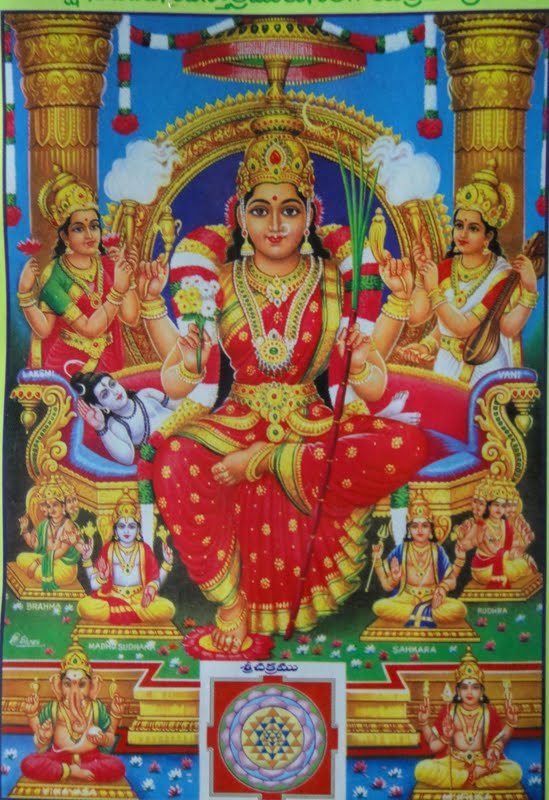
BHUVANESHWARI – The Goddess is known as World Mother. “Bhuvana” means “this living world” and “isvari” means “ruler.” She embodies all the characteristics of the cosmos. She is identified with the manifest world and all that we experience within it. The entire universe is said to be her body and all the beings are ornaments of her infinite being. She carries all the worlds as a flowering of her own Self-nature.
The symbolism of Bhuvaneshwari, who is all pervasive and completely identifies with the universe, is an invitation for us to cultivate an attitude of universality. She represents the power of openness and infinite expansion, of equanimity in spirit and profound peace that contains in it all things that cannot be disturbed.
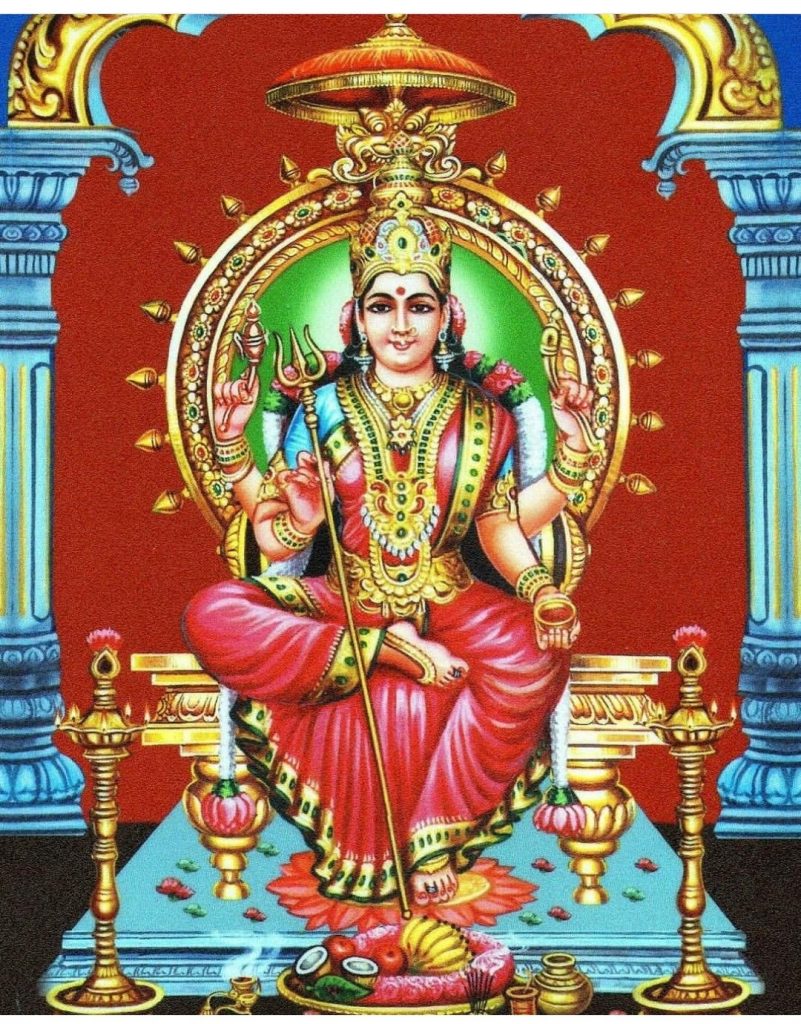
BHAIRAVI – The fierce and terrifying aspect of Devi, also called Shubhamkari, is believed as a good mother to good people and terrible to the bad ones. She evokes terror and fear and is seen seated on a headless corpse in a cremation ground with four arms. In one hand she’s holding a sword of knowledge and in another a demon’s head while two arms are shown in mudras – one abhayamudra which teaches us to have no fear and the other varadamudra that grants all boons.
Bhairavi symbolizes the maternal instinct to protect offspring. She destroys ignorance and helps us overcome the negative forces that exist within ourselves and at the same time manifest our material desires.
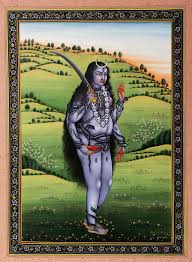
CHINAMMASTA – She is known as the self-decapitated Goddess. The Panchatantra Grantha tells the story of Parvati who once goes to bathe in the Mandakini river with her two close friends. As the day progresses, the friends get hungry and ask Parvathi for food. She keeps putting them off until their demands grow incessant. At one point, she laughingly cuts off her head using her fingernail and blood spurts out in three directions. The two friends drink in the blood from two founts, while Parvati drinks from the third.
The severed head symbolize liberation. However, the most symbolic message of this form of the Goddess is that we all possess rare courage needed to make the ultimate sacrifice.
The blood spurting from her neck represents prana (cosmic life force) which sustains her own life as well as that of all other beings in the universe.
Chinnamasta can also be interpreted as an awakening of the kundalini in each one of us as we rid ourselves of our mistaken identities and overcome limitations that hinder our spiritual progress.
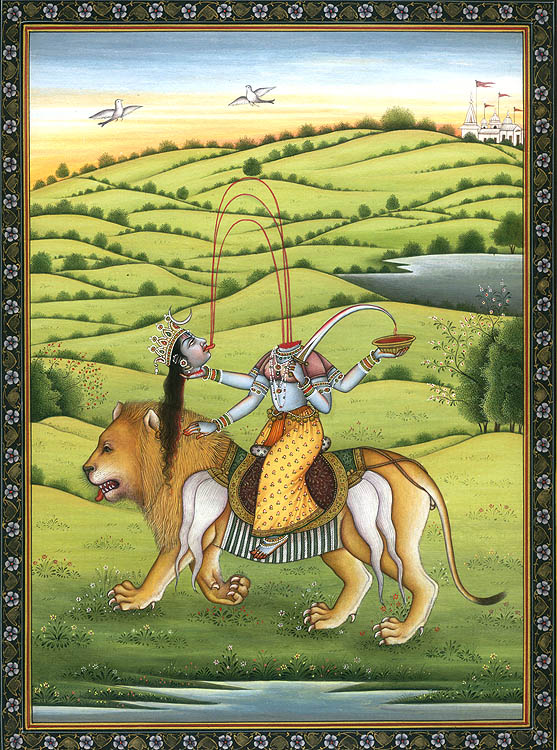
DHUMAVATI – She is the one made of smoke – that which is dark, polluting and conceals the truth – the worst facets of humanity. This transcendent power shows us that a dark side of life is very much a reality that we all have to confront. This form of the Divine Consciousness is associated with poverty, hunger, thirst and anger – all the aspects of living which everyone wishes to avoid.
Dhumavati stands for the corrosive power of time that robs us of all that is valuable to us – loved ones, beauty, vigour, vitality. The lesson from Dhumavati is to understand the transient nature of all the experiences. She is a great teacher who reveals the ultimate knowledge of the universe and teaches us to cultivate a sense of detachment from our senses.

BAGALAMUKHI – She is the one who paralyzes enemies. This form of Devi smashes misconceptions and delusions (enemies of spiritual growth). Tantra Shastra describes her as sitting on a golden throne in the middle of an ocean. Though generally depicted as a goddess with a human head, she is also shown with the head of a crane in some iconography.
She ceases all motion at the appropriate time and silences the mind. She is praised as the giver of siddhi and riddhi (supernatural and magical powers) to her devotees who seek her with sadhana.
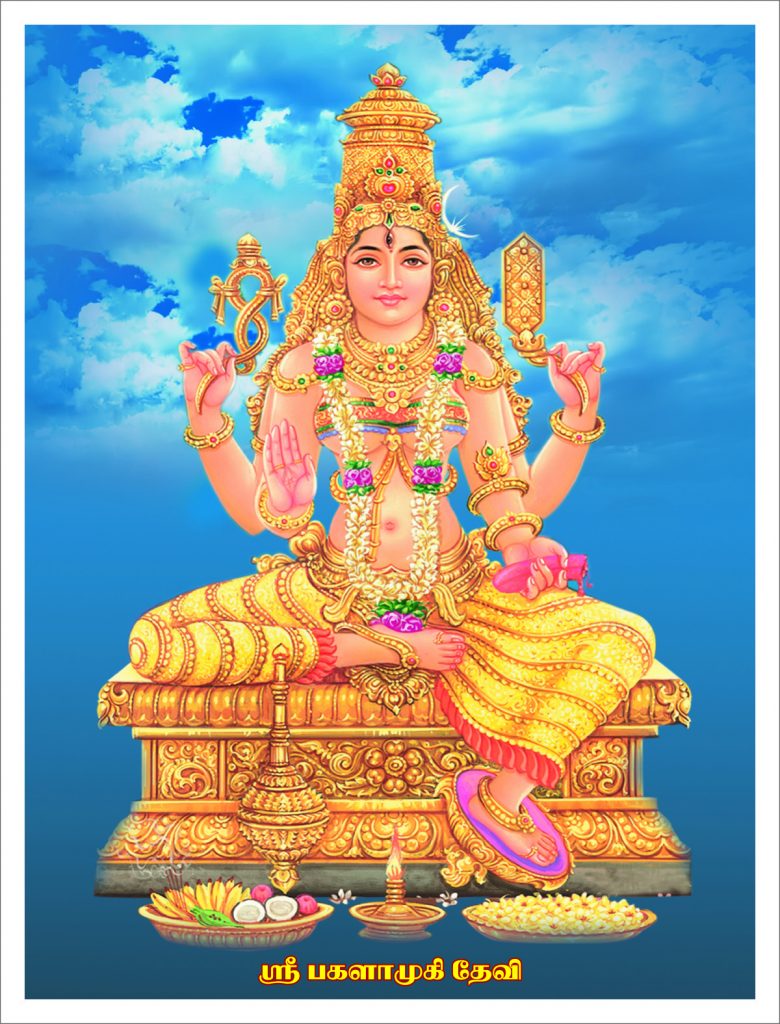
MATANGI – The tantric form of Goddess Saraswathi is another ferocious aspect of Devi. The Dhyana mantra of Brhat Tantrasastra describes Matangi as seated on a corpse, wearing red garments and red jewellery, carrying a skull and a sword in her two hands. Worship of Matangi is said to give her devotees the ability to face the forbidden, transcend pollution of the senses and lead them to gain supernatural powers for attaining worldly goals and ultimately salvation. Meditation on Matangi is prescribed especially to gain control over enemies, attract people and acquire mastery over the arts.

KAMALA -The Lotus Goddess, called the “Tantric Lakshmi,” is a form that holds the promise of wealth, prosperity and well-being. She sits holding a lotus with two hands and bestowing blessings with the other two. The lotus is a recurrent symbol of the manifest universe in the Hindu tradition. It grows out of the murky water but brings forth beauty and fragrance. In the same way, it is possible for us humans, with our restricted material body, amidst all the pollution of life, to rise above and emerge as Divine Consciousness.
Kamala symbolize the unfolding of inner consciousness much like the petals of a lotus. She is worshipped in the hope of bringing material wealth. The lesson from Kamala is to see beauty in everything around us and to understand that true wealth is only achieved when it is selflessly shared with others.
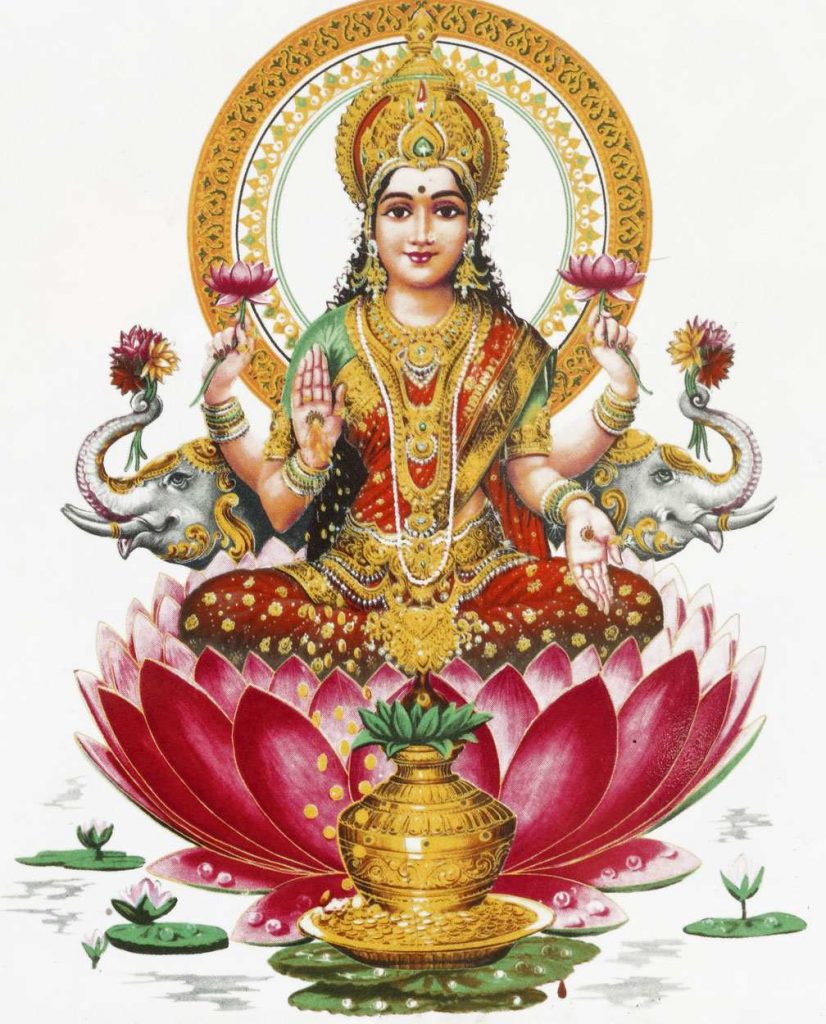
Undoubtedly, the Mahavidya, as a group with its individual deities, depicts some of the most unusual, fierce, strange and vivid gods ever portrayed in any major world religion or culture. The forms are radically different from the benign and beautiful gods worshipped in the “cultured” society. They challenge accepted norms of social order with their outlandish behaviour, grotesque bodies, ugly faces and bizarre habits. These outrageous manifestations are meant to shock us and compel us to look beyond our comfort zones. The disturbing and distressing aspects force us to look deeper into our own selves to identify our shortcomings and show us for what we are, not what we are meant to be.
By rejecting and subverting conventionally accepted norms, the Mahavidya seeks to expand awareness to liberate the mind from inhibitions and prejudices.
An interesting aspect of the Mahavidya is that even though they are all about the power of the feminine principle, the deities are not shown as wives (although spouses are named in a few forms) or as mothers.
It is natural to wonder about the reason why our ancient seers divided all the great knowledge into ten diverse aspects. Vedic scholars have indicated that it was an effort to drive home certain important points:
- The Divine Mother is Absolute, ineffable and immutable and is beyond time and space.
- In the act of creation, she subjects herself to constraints of time and space.
Time is an aspect of prakruthi (Nature) and one of the 36 tattvas or principles of creation. However, as a concept, it is a creation of our intellect based on our sensory perception. It is a part of “Maya” or illusory state in which we all exist. For the Divine Consciousness, there is no division of time – there is only the present moment, a continuous and undivided state of existence.
Space is vast and beyond our comprehension. It is infinite, without a beginning or an end. To simplify matters, we divide it into ten cardinal directions – East, West, North, South, South-east, South-west, North-east, North-west, above and below.
- Knowledge is one but is understood in ten different ways based on our five sense organs and five organs of action – skin, eye, ear, nose, tongue, mouth, foot, hand, anus and genitalia.
- Truth is one but we perceive it in various facets, shapes, forms and meanings.
S. Shankaranarayanan says in his article on “The Ten Great Cosmic Powers”:
“Each has a particular Cosmic function and leads to a special realization of the One Reality. The might of Kali, the sound-force of Tara, the beauty and bliss of Sundari, the vast vision of Bhuvaneshwari, the effulgent charm of Bhairavi, the striking force of Chinnamasta, the silent inertness of Dhumavati, the paralyzing power of Bhagalamukhi, the expressive play of Matangi and the concord and harmony of Kamala are the various characteristics, the distinct manifestations of the Supreme Consciousness that have made this creation possible. The Tantra says that the Supreme can be realized at these various points.”
Each one of the Mahavidya holds individual significance as Brahmavidya and together as a group they contain all the wisdom of the universe – of past, present and the future and all the potential that ever existed or will exist. A true learner, who seeks with devotion, will be guided and inspired to find the spiritual strength and capability lying dormant within him to have his dreams manifested through a study of these great systems of knowledge.
Bhairavi, Bhuvaneshwari and Chinnamasta are called Vidya; Dhumavathi, Bagalamukhi, Matangi and Kamala are called Siddhi Vidya; The forms of Kali and Tara are considered to be Mahavidya. Tripurasundari is called Sri Vidya. Tripurasundari is the foremost of the Mahavidyas and is seen as the highest aspect of Adi Parashakti. The Tripura Upanishad mentions her as the ultimate Shakti, giving energy and power to the universe. She is described as the supreme consciousness, with her position higher than that of Shiva, Vishnu and Brahma. The text is one of the important texts of the Shakta tradition and notable for its theory of Tripura (literally “three cities”) symbolizing the three roads of work, worship and wisdom.
The Sanskrit word ‘Tripura’ is a combination of two Sanskrit words; “Tri” meaning “tráyas (three)” and “pura” meaning a city or citadel, understood as referring to the three states of consciousness (waking, dreaming and sleeping). Therefore, “Tripura Sundarī” literally means “She who is beautiful in the three states of consciousness”.
In the waking state, consciousness is turned outward to the external world as we perceive the world through our senses and experience the gross objects of the physical world around us. In this second state which is the dreaming state, consciousness is turned towards the inner world. In the third state also known as Sushupti in Sanskrit, the senses are not operating either looking at external objects or focused on the internal state. In deep sleep, all experiences have receded into a realm of undifferentiated consciousness.
David Kinsley, describes Lalita Tripurasundari in his book Tantric Visions of the Divine Feminine: The Ten Mahavidyas “She is called Tripura because she is identical with the triangle (trikona) that symbolizes the yoni and that forms her chakra. She is also called Tripura because her mantra has three clusters of syllables. Here Tripura is identified with the alphabet, from which all sounds and words proceed and which is often understood to occupy a primordial place in tantric cosmology. She is three-fold, furthermore, because she expresses herself in Brahma, Vishnu, and Shiva in her roles as creator, maintainer, and destroyer of the universe. She is threefold also because she represents the subject (maul), instrument (mina), and object (meya) of all things. Here again, she is identified with reality expressed in terms of speech, which involves a speaker, what is said, and objects to which the words refer.”
Another unique feature of Sri Vidya which many scholars have pointed out is that the name of the Vidya/ Goddess/ Yantra are synonymous with Sri and there is no other name ascribed to the manifestations. For example, the Vidya is not called Lalita Vidya or Tripurasundari Vidya. Similarly the Yantra is not called Lalita Yantra (notice how all other yantras carry the names of the deities such as Ganesha Yantra, Kali Yantra, Kubera Yantra). This points to the fact that Sri Vidya is so powerful and all-encompassing that it does not need another name.
In the Rig Veda, Sri Vidya is found as Sri Sukta. While in the Brahmanda Purana there is a comprehensive description of Sri Vidya, its method and philosophy, it also finds mention in the Bhavanopanishad, Shiva Sutras and Sri Vijjana Bhairava. The Bhavanopanishad is a major Sri Vidya text that postulates the symbolism of the Sri Chakra and outlines how this yantra is to be worshipped. The Saundarya Lahiri, composed by Adi Shankaracharya, is a hymn consisting of one hundred verses expounding the virtues of Lalitha Tripurasundari. It is considered the most beautiful and profound explanation of Sri Vidya and the Lalita Sahasranama, a very auspicious prayer containing one thousand names of the Devi is found in Brahmanda Purana in the form of a discussion between Hayagreeva and sage Agasthya.
It is said that Brahma, Vishnu, Shiva and the seven great rishis (saptarishis) of the Hindu tradition have all been Sri Vidya Upasakas. Adi Shankaracharya was a greatest exponent of Sri Vidya and was instrumental in spreading this knowledge across India. Bhaskararaya, a renowned spiritual scholar who later took up sannyasa was one of the foremost promoters of Sri Vidya in the 18th century. Sri Ramakrishna Paramahamsa and Swami Vivekananda are also known to be Sri Vidya upasakas who helped lend credibility and greater awareness to this school of worship. In modern times, Swami Amritananda and his disciple Raja Choudhury, Om Swami, Swami Karunamaya and Sri M have been great exponents of Sri Vidya. I am sure there are many more enlightened Upasakas whom I have not heard of but the names I have mentioned above are people I have learnt a great deal from their talks and writings on the subject.
Swami Veda Bharati writes that “Sri Vidya begins where the current understanding of quantum physics ends. It is the science of sciences, the mega-science and the art of arts, the mega art. Wherever we study configurations, charts and graphs it is a part of Sri Vidya. Wherever we study forms as fields of energy it is Sri Vidya. Wherever we study Marmas in Ayurveda, this too is a part of Sri Vidya. But it is experienced only in the assimilation of these principles into our consciousness not in an intellectual process but in our very being in our very essence so that our essence is not seen apart from the ever- expanding and contracting universe. “
569 total views, 1 views today

